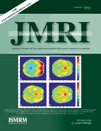Effects of respiratory cycle and body position on quantitative pulmonary perfusion by MRI
Abstract
Purpose:
To evaluate the performance of lung perfusion imaging using two-dimensional (2D) first pass perfusion MRI and a quantitation program based on model-independent deconvolution algorithm.
Materials and Methods:
In eight healthy volunteers 2D first pass lung perfusion was imaged in coronal planes using a partial Fourier saturation recovery stead state free precession (SSFP) technique with a temporal resolution of 160 ms per slice acquisition. The dynamic signal in the lung was measured over time and absolute perfusion calculated based on a model-independent deconvolution program.
Results:
In the supine position mean pulmonary perfusion was 287 ± 106 mL/min/100 mL during held expiration. It was significantly reduced to 129 ± 68 mL/min/100 mL during held inspiration. Similar differences due to respiration were observed in prone position with lung perfusion much greater during expiration than during inspiration (271 ± 101 versus 99 ± 38 mL/min/100 mL (P < 0.01)). There was a linear increase in pulmonary perfusion from anterior to posterior lung fields in supine position. The perfusion gradient reversed in the prone position with the highest perfusion in anterior lung and the lowest in posterior lung fields.
Conclusion:
Lung perfusion imaging using a 2D saturation recovery SSFP perfusion MRI coupled with a model-independent deconvolution algorithm demonstrated physiologically consistent dynamic heterogeneity of lung perfusion distribution. J. Magn. Reson. Imaging 2011;. © 2011 Wiley-Liss, Inc.




